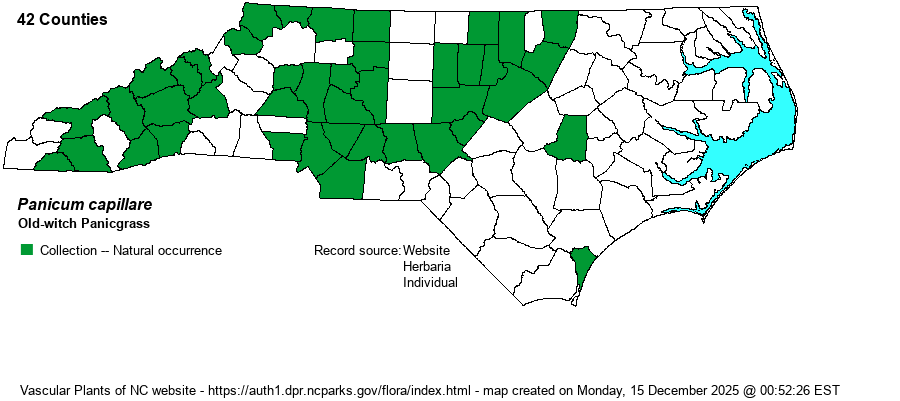| Author | L. | |
| Distribution | Mountains and Piedmont; also Wayne County (roadside) and New Hanover County (habitat unknown).
ME to B.C., south to FL and TX; Bermuda. | |
| Abundance | Fairly common to frequent in the Mountains and Piedmont, rare on the Coastal Plain. | |
| Habitat | Dry rocky or sandy soils of open woodlands, glades, outcrops, clearings, roadsides, fields. In the Piedmont, many records are from mafic substrates and shrink-swell soils. | |
| Phenology | Flowering and fruiting August-October. | |
| Identification | This panicgrass has a very open, airy inflorescence that is very broadly ovate in outline, with spikelets 2-4 mm long. The plants usually grow 1-2 feet tall. In late fall, the inflorescences break off and roll about like a tumbleweed. Small examples may be confused with P. philadelphicum, but differ in the much larger inflorescence and the larger spikelets (2-4 mm long vs. a maximum of 2.4 mm long in that species). | |
| Taxonomic Comments | None
The genus Panicum in the broad sense was once very large, but with the split of Dichanthelium in the 1980s, it has been reduced to manageable size. In more recent decades, other genera have been split off: Coleataenia, Hymenachne, Kellochloa, and Phanopyrum, as examples. All 6 of these genera can be readily told from each other in the field with just a hand lens. For a more detailed discussion, see the introductory paragraphs in Weakley (2018). | |
| Other Common Name(s) | Witch Panicgrass. Most references call it just Witchgrass, but that is the group common name for another genus -- the split off (from Panicum) Dichanthelium species. | |
| State Rank | S4 | |
| Global Rank | G5 | |
| State Status | | |
| US Status | | |
| USACE-agcp | FAC link |
| USACE-emp | FAC link |

